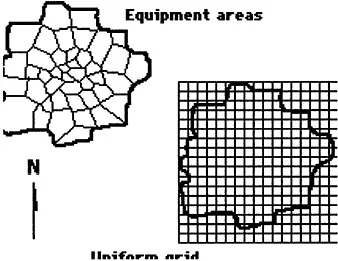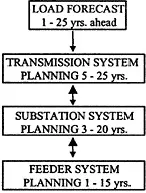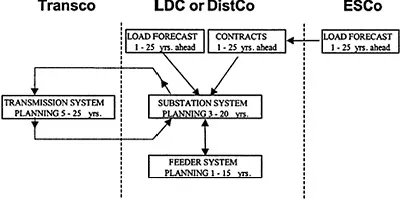
- 760 pages
- English
- ePUB (mobile friendly)
- Available on iOS & Android
eBook - ePub
Spatial Electric Load Forecasting
About this book
Containing 12 new chapters, this second edition offers increased coverage of weather correction and normalization of forecasts, anticipation of redevelopment, determining the validity of announced developments, and minimizing risk from over- or under-planning. It provides specific examples and detailed explanations of key points to consider for both standard and unusual utility forecasting situations, information on new algorithms and concepts in forecasting, a review of forecasting pitfalls and mistakes, case studies depicting challenging forecast environments, and load models illustrating various types of demand.
Frequently asked questions
Yes, you can cancel anytime from the Subscription tab in your account settings on the Perlego website. Your subscription will stay active until the end of your current billing period. Learn how to cancel your subscription.
No, books cannot be downloaded as external files, such as PDFs, for use outside of Perlego. However, you can download books within the Perlego app for offline reading on mobile or tablet. Learn more here.
Perlego offers two plans: Essential and Complete
- Essential is ideal for learners and professionals who enjoy exploring a wide range of subjects. Access the Essential Library with 800,000+ trusted titles and best-sellers across business, personal growth, and the humanities. Includes unlimited reading time and Standard Read Aloud voice.
- Complete: Perfect for advanced learners and researchers needing full, unrestricted access. Unlock 1.4M+ books across hundreds of subjects, including academic and specialized titles. The Complete Plan also includes advanced features like Premium Read Aloud and Research Assistant.
We are an online textbook subscription service, where you can get access to an entire online library for less than the price of a single book per month. With over 1 million books across 1000+ topics, we’ve got you covered! Learn more here.
Look out for the read-aloud symbol on your next book to see if you can listen to it. The read-aloud tool reads text aloud for you, highlighting the text as it is being read. You can pause it, speed it up and slow it down. Learn more here.
Yes! You can use the Perlego app on both iOS or Android devices to read anytime, anywhere — even offline. Perfect for commutes or when you’re on the go.
Please note we cannot support devices running on iOS 13 and Android 7 or earlier. Learn more about using the app.
Please note we cannot support devices running on iOS 13 and Android 7 or earlier. Learn more about using the app.
Yes, you can access Spatial Electric Load Forecasting by H. Lee Willis in PDF and/or ePUB format, as well as other popular books in Technology & Engineering & Electrical Engineering & Telecommunications. We have over one million books available in our catalogue for you to explore.
Information
1
Spatial Electric Load Forecasting
1.1 SPATIAL LOAD FORECASTING
In order to plan the efficient operation and economical capital expansion of an electric power delivery system, the system owner must be able to anticipate the need for power delivery—how much power must be delivered, and where and when it will be needed. Such information is provided by a spatial load forecast, a prediction of future electric demand that includes location (where) as one of its chief elements, in addition to magnitude (how much) and temporal (when) characteristics.
Figure 1.1 shows the spatial nature of electric load growth over time, in this case the anticipated growth of electric demand in a metropolitan area in the central United States. Over a twenty-year period, the total electric demand in this city is expected to increase by nearly fifty percent. Growth is expected to affect numerous existing areas of the system— those where load already exists—where the present demand is expected to increase substantially. Facilities in these areas can be expected to be much more heavily loaded in the future, and may need enhancement or redesign to greater capacity.
The growth also includes considerable spread of electric demand into currently vacant areas, where no electric demand exists. Here, the utility must schedule additions of equipment and facilities to meet the demand as it develops.

Figure 1.1 Maps of peak annual demand for electricity in a major American city, showing the expected growth in demand during a 20-year period as determined using a comprehensive simulation-based method. Growth in some parts of the urban core increases considerably, but in addition, electric load spreads into currently vacant areas as new suburbs are built to accommodate an expanded population.
In addition, a forecast as shown in Figure 1.1 identifies areas where no electric load growth is expected—information quite useful to the utility planner, for it indicates those areas where no new facilities will be needed. In other areas, electric demand may decrease over time, due to numerous causes, particularly the deliberate and planned actions that the utility or the energy consumers on its system may take to reduce energy consumption—demand side management (DSM). Spatial analysis of how these reductions might impact future transmission and distribution (T&D) requirements is a useful feature of electric utility planning, and can be accommodated by some types of spatial forecasting methods. In addition, competitive market assessment and open access planning of electric systems require spatial analysis of the market—the electric demand, and how it will react to changes in price and availability of electric power and its competing energy sources, such as gas and solar power.
Small Area Forecasting
A very wide variety of methods exist to forecast electric demand growth on a spatial basis. In all of these, geographic location of load growth is accomplished by dividing the utility service territory into many small areas, as shown in Figure 1.2. These might be irregularly shaped areas of varying size, as for example, the service areas of substations or feeders in the system, or they might be square areas defined by a grid. Any technique that forecasts load by extrapolating recent growth trends on a feeder—or substation area-basis is a small area forecasting method (although perhaps not a very accurate one) that works on irregularly shaped and sized areas.
The spatial forecasts shown in Figure 1.1 were accomplished by dividing the region studied into 60,000 square areas, each 1/4 mile wide (40 acres). Some spatial forecast methods work with square areas as small as 2.5 acres (1/16 mile wide), analyzing as many as 3,000,000 at one time. Regardless, all spatial forecasts work on a small area basis, but as will be discussed later in this book, not all small area forecasts are spatial forecasts. A spatial forecast involves the coordinated forecast of all small areas in a region, using a consistent and coherent set of assumptions and characteristic factors. Many small area forecast methods, particularly trending, do not, strictly speaking, accomplish this coordination.

Figure 1.2 Spatial load forecasts are accomplished by dividing the service territory into small areas, either irregularly shaped areas, perhaps associated with equipment service areas, or elements of a uniform grid.
1.2 T&D PLANNING
Electric power delivery is among the most capital intensive of businesses. The required transmission and distribution (T&D) facilities need rights-of-way and substation sites, power equipment for transmission, distribution, protection and control, and extensive construction labor, all involving considerable expense. Arrangements for new or expanded facilities normally require several years, meaning that a power delivery utility usually must plan at least five years ahead. For a variety of reasons, most utilities wants to evaluate the wisdom and value of their investments over a portion—roughly the first half—of their service lifetimes, meaning that long-range planning needs to look out another ten to fifteen years into the future. Thus, power delivery utilities need to plan, in various ways, over a period as far as fifteen or twenty years into the future.
Planning is a decision-making process that seeks to identify the best schedule of future resource commitments and actions to achieve the utility’s goals. Ordinarily, these goals include financial considerations—minimizing cost and maximizing profit—along with service quality and reliability standards, as well as other criteria, including environmental impact, public image, and future flexibility.
Generally, the objective of the T&D planning process is to determine an orderly and economical expansion of equipment and facilities to meet the utility’s future electric demand with an acceptable level of reliability. This involves determining the sizes, locations, interconnections, and timing of future additions to transmission, substation, and distribution facilities, and perhaps a compatible program of “nontraditional distributed resource” commitments as well—such things as demand-side management, distributed generation and storage, and automation. Such planning is a difficult task, compounded by recent trends of tightening design margins, lengthening equipment lead times, and increasing regulatory scrutiny.
Traditional T&D Planning
Traditionally, T&D planning was a standards-based planning process. An electric utility’s Engineering Department set certain standards for equipment type, characteristics, loading, and usage, as well as standards for voltage drop, power factor, utilization, contingency margin, and other operating parameters for the system (see Willis, 1998, Chapters 4 and 5). Planners then attempted to develop a plan that met all standards and criteria and had the lowest possible cost. “Lowest cost” was rigorously defined by decree/agreement with state regulatory authorities. It usually meant that all costs were considered, and that the utility attempted to minimize the total revenue requirements needed to serve its consumers’ demand. Minimizing revenue requirements meant that the utility considered operating and financing costs as well as initial capital costs in deciding if one option was less expensive than another.

Figure 1.3 The traditional T&D planning process in a vertically integrated electric utility. The spatial load forecast is the first step, driving the rest of the planning process.

Figure 1.4 The T&D planning process in a de-regulated power industry. “Planning” (the study of the future, assessment of needs and options, selection of strategy and development of tactics to achieve it) is now part of three organizations. These include one or more electric service companies (ESCos), the local distribution company, which may be a pure wire company (Distco) or have an interest in selling energy, too (LDC—local distribution company), and the transmission owner-operator (Transco or regional transmission authority). Communications between all (crossing the dotted lines) are heavily regulated and formalized. Both the ESCos and delivery companies have an interest in spatial forecasting.
Figure 1.3 shows the traditional T&D planning process as it was often represented, consisting of transmission, substation, and distribution-level planning. The exact organization and emphasis of these individual planning steps would vary from one utility to another. Regardless, a key element of the overall planning was the load forecast, the first step. That defined the capabilities the future system needed to possess. If the forecast was poorly or inappropriately done, then subsequent steps were directed at planning for future loads different than would develop, and the entire planning process was at risk.
Table 1.1 shows typical traditional lead times required to plan, permit, and put into place facilities at various levels of an electric T&D system. Conditions and requirements varied from one situation to another, but the values shown are illustrative. Larger, high voltage equipment requires longer lead times. Smaller equipment at the lower voltage levels can be installed with a shorter lead time.
Modern T&D Planning
T&D planning at the beginning of the 21st century is decidedly different from traditional T&D planning, in both operating environment and planning focus. To begin, most of the power production and bulk transmission in the power industry has been de-regulated. It is under federal regulatory control, and regulated in a way that fosters competition and provides minimal protection for business risk, but a great deal of reliability protection and a certain amount of price protection for energy consumers.
De-regulation has brought about disaggregation of power delivery systems, and a change in the entities planning “their parts” of the utility industry, as shown in Figure 1.4. Somewhere in the chain of power flow from generator to consumer, a dividing line has been drawn between the wholesale grid and the energy delivery systems, and perhaps between the energy delivery and the retail marketer(s). The de-regulated electric power landscape provides a bewildering array of slightly different ways of organizing the local electric industry. Readers needing more detail may wish to consult a reference on the industry’s structure (e.g., Philipson and Willis, 1999).
Under de-regulation, transmission is owned by a Transco (transmission company) and operated by an ISO (independent system operator) or RTO (regional transmission operator). Distribution is owned by a Distco or an LDC (local distribution company). For purposes of this discussion, four entities will be identified as composing the “power industry,” only three of which are discussed here:
Genco—the various companies that own and operate generation, sell power into the competitive wholesale grid and provide related services (load following, etc). They are not a concern here and are listed only for completeness.
TransCo—the owner(s) and/or operator of the bulk power transmission system in the region. “Bulk power transmission” is defined here as transmission connected to generators, but not to consumers (except very large industries that buy power on the competitive market). Strictly speaking, Transco means the transmission owner, but it will be used here to refer to whoever is making the plotting the future of and the decisions about expansion and investment in the bulk power transportation system for the region.
DistCo or Local Distribution Company (LDC)—the company that operates the wires down to and including the connection to the end energy consumers. A “DistCo” owns and operates the wires, providing the service of connectivity and power delivery, but sells no power (it merely moves power for ESCos). A local distribution company (LDC) provides this service, and sells the power itself.
Energy service companies (ESCos) retail power, buying it at the...
Table of contents
- COVER PAGE
- TITLE PAGE
- COPYRIGHT PAGE
- SERIES INTRODUCTION
- PREFACE
- 1. SPATIAL ELECTRIC LOAD FORECASTING
- 2. CONSUMER DEMAND FOR POWER AND RELIABILITY
- 3. COINCIDENCE AND LOAD BEHAVIOR
- 4. LOAD CURVE AND END-USE MODELING
- 5. WEATHER AND ELECTRIC LOAD
- 6. WEATHER-DESIGN CRITERIA AND FORECAST NORMALIZATION
- 7. SPATIAL LOAD GROWTH BEHAVIOR
- 8. SPATIAL FORECAST ACCURACY AND ERROR MEASURES
- 9. TRENDING METHODS
- 10. SIMULATION METHOD: BASIC CONCEPTS
- 11. A DETAILED LOOK AT THE SIMULATION METHOD
- 12. BASICS OF COMPUTERIZED SIMULATION
- 13. ANALYTICAL BUILDING BLOCKS FOR SPATIAL SIMULATION
- 14. ADVANCED ELEMENTS OF COMPUTERIZED SIMULATION
- 15. HYBRID TRENDING-SIMULATION METHODS
- 16. ADVANCED DEMAND METHODS: MULTI-FUEL AND RELIABILITY MODELS
- 17. COMPARISON AND SELECTION OF SPATIAL FORECAST METHODS
- 18. DEVELOPMENT DIMENSIONALITY: URBAN, RURAL AND AGRARIAN AREAS
- 19. METROPOLITAN GROWTH AND URBAN REDEVELOPMENT
- 20. SPATIAL LOAD FORECASTING IN DEVELOPING ECONOMIES
- 21. USING SPATIAL FORECASTING METHODS WELL
- 22. RECOMMENDATIONS AND GUIDELINES